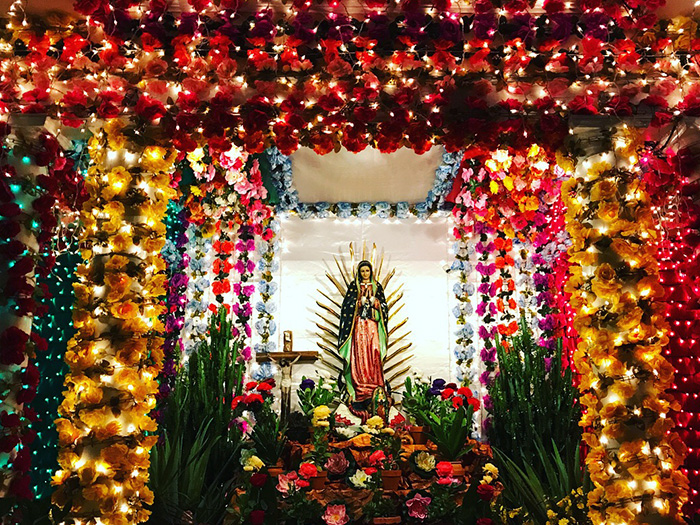Luis Cantabrana stands tall and proud in the front yard of his home in Santa Ana, California. Twinkling lights illuminate his face as he watches commuters and pedestrians alike stop and gawk at his creation — an altar devoted to the Virgen de Guadalupe.
But it’s not just a statue surrounded by votive candles. Thousands of white lights plastered on what’s usually Cantabrana’s porch surround a four-foot-tall Guadalupe, who stands right in front of what’s usually the front door. Fake roses wrap around the porch’s columns; bouquets of real flowers and votive candles line the steps leading up to her. Smaller statues of la Guadalupana peek out, along with other Catholic saints that people have left behind: St. Jude Thaddeus. The Santo Niño de Atocha. Other Marys.
All of this is in the middle of even more lights that cover the rest of the front of the Cantabrana home — green on the left, red on the right — so that the entire scene look like the Mexican flag. To finish off the display, the roof of the Craftsman-style home features still even more lights to form a Christmas tree, two crosses, a smaller shrine, and the words: “VIRGEN DE GUADALUPE.”
Cantabrana has created this pop-up shrine for the past six years at this location to celebrate the patron saint of Mexico. And before that, the father of three (married to a woman named María) did the same for 12 years at a previous, smaller home in Santa Ana. He got the inspiration after a friend invited him to visit a local church and sing “Las Mañanitas” to Guadalupe.

“She only had three simple bouquets,”Cantabrana tells me in Spanish. The sparse display moved him to do something worthy of her, the way his family used to do it in their home state of Nayarit.
“Where I come from, we have a big celebration for the Virgen de Guadalupe on the 12th of January and I wanted to share that same celebration with our community,” says the 50-year-old landscaper. “Here, we begin on the December 3rd leading up to the final day of festivities on December 12th.”
With the help of family and soccer players that he coaches, Cantabrana starts to decorate on November 15 so the shrine is ready by Thanksgiving. “Before, it would take me a month, because I didn’t know how to do it and it was just me,” he says. “Now, it takes me two weeks.”
For the two weeks leading up to December 12, the faithful recite the Rosary every night underneath two large tents that Cantabrana sets up. At first, it used to be just friends and neighbors; this year, he estimates 300 people attended the final two days, many from other cities. Visitors brought tamales and hot chocolate; Cantabrana gave out water and sodas for free. As more people came, he and his two sons folded out more chairs that they rented. Local singer Edith Gonzalez sang devotional songs like “Buenos Días, Paloma Blanca.” Also making an appearance: los chinelos, folkloric dancers from the state of Morelos famous for their fabulous costumes and tireless dancing to the sounds of tamborazo.
After the 12th, people sometimes gather to say prayers for Christmas Eve and Dia de los Reyes Magos, the day the shrine finally goes down. But the rest of the time, Cantabrana just leaves the shrine alone to allow pilgrims to venerate Guadalupe on their own terms.
“As long as I have a place to make my altar and I have the means and I’m living, I will continue to do it,” Cantabrana says, looking up at her. “It’s something that is good, and we do to be united.”
Editor’s Note: Several municipalities in Nayarit celebrate La Virgen de Guadalupe in January.







